Accelerate > Publications
Search this online library featuring the latest FAO publications, issue papers and briefs which offer up-to-date knowledge and innovative insights for SDG acceleration.

Water stress plugin for Water Evaluation and Planning system (WEAP): Using the water evaluation and planning tool for the calculation of Sustainable Development Goal indicator 6.4.2
2024
This report presents the instruction manual of the new water stress plugin developed by FAO in collaboration with the Stockholm Environment Institute's U.S. Center (SEI) for the calculation of the SDG indicator 6.4.2 “Level of water stress: freshwater withdrawal as a proportion of available freshwater resources” by river basin.

FAO and the 2030 Agenda Follow-up and Review: Guidance Note for Regional and Country Offices
2023
The Guidance Note describes the process of the preparation of the VNRs and what FAO Regional and Country Offices need to be aware and mindful of when providing support to the national partners. It covers information about the importance of the follow-up and review process for the 2030 Agenda and the SDGs, including information about the gaps in the coverage of the Voluntary National Reviews, and recommendations on strengthening VNRs to be meaningful instruments for the acceleration of the SDGs.

The State of Food and Agriculture 2023 - Revealing the true cost of food to transform agrifood systems
2023
The State of Food and Agriculture 2023 looks into the true cost of food for sustainable agrifood systems. The report introduces the concept of hidden environmental, health and social costs and benefits of agrifood systems and proposes an approach – true cost accounting (TCA) – to assess them.

FAO SDG Action: Marking the mid-way point of the 2030 Agenda
2023
As we stand at the midpoint of the 2030 Agenda, it is both a moment of reflection and an opportunity to renew our commitment to achieving the SDGs. In August 2023, the FAO Office of SDGs launched a survey, receiving over 600 responses that shared valuable insights, experiences and actions taken by FAO offices towards the achievement of the SDGs. In addition this survey, FAO project data was leveraged to present this visual representation of FAO’s contribution to the 2030 Agenda implementation.
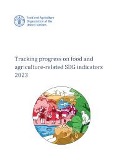
Tracking progress on food and agriculture-related SDG indicators 2023
2023
At the mid-point of the Agenda 2030 for Sustainable Development, there is an urgent need to understand where the world stands in eliminating hunger and food insecurity, as well as in ensuring sustainable agriculture. The new report of the Food and Agriculture Organization of the United Nations (FAO),offers analysis and trends on indicators across eight Sustainable Development Goals (SDGs) – in particular, SDGs 1, 2, 5, 6, 10, 12, 14 and 15.

2023 SDG Summit: FAO Key Messages
2023
The 2023 SDG Summit will serve as a pivotal event towards achieving the SDGs, as gathered Heads of State and Government are to carry out a comprehensive review of progress, respond to the impact of multiple crises, and provide high-level political guidance on transformative and accelerated actions for achieving the 2030 Agenda. FAO has developed these key messages to inform the discussions in the lead up to and during this Summit and the Political Declaration which will result from them.
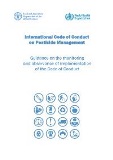
International Code of Conduct on Pesticide Management - Guidance on the monitoring and observance of implementation of the Code of Conduct
2023
The objective of this guidance on fulfilling the reporting requirements of Article 12 of the Code of Conduct is to obtain a regular flow of information on its observance to strengthen implementation of the Code, to provide data for its future revisions and improvement, and, most importantly, to improve the protection of human health and the environment related to pesticide use and management in agriculture and public health.

Progress on the level of water stress. Global status and acceleration needs for SDG indicator 6.4.2, 2021
2023
The global indicator on water stress tracks the level of pressure that human activities exert over natural freshwater resources, indicating the environmental sustainability of the use of water resources. A high level of water stress has negative effects on social and economic development, increasing competition and potential conflict among users. This report is part of a series that tracks progress towards the various targets set out in SDG 6 using the SDG global indicators.

A rapid review of effective financing for policy, implementation and partnerships addressing drought risks
2022
The report presents an overview of current knowledge and thinking concerning the effectiveness of three distinct layers of financing that set out to address drought risks in different ways. For each of these, results are conceptualized and measured in different ways for disaster risk reduction, adaptation to climate change, and transformative green finance.
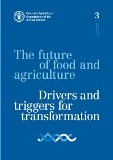
The future of food and agriculture – Drivers and triggers for transformation
2022
This report aims at inspiring strategic thinking and actions to transform agrifood systems towards a sustainable, resilient and inclusive future, by building on both previous reports in the same series as well as on a comprehensive corporate strategic foresight exercise that also nurtured FAO Strategic Framework 2022–31. It analyses major drivers of agrifood systems and explores how their trends could determine alternative futures of agrifood, socioeconomic and environmental systems.
Tracking progress on food and agriculture-related SDG indicators 2022
2022
Seven years into the 2030 Agenda, there is an urgent need to understand where the world stands in eliminating hunger and food insecurity, as well as in ensuring sustainable agriculture. FAO’s new report, “Tracking progress on food and agriculture-related SDG indicators”, offers analysis and trends on indicators across eight SDGs (1, 2, 5, 6, 10, 12, 14 and 15), highlighting areas of progress and areas where further effort is needed.
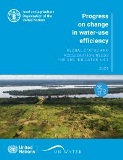
Progress on change in water-use efficiency - Global status and acceleration needs for SDG indicator 6.4.1, 2021
2021
The global indicator on water-use efficiency tracks to what extent a country’s economic growth is dependent on the use of water resources, and enables policy and decision-makers to target interventions at sectors with high water use and low levels of improved efficiency over time.

Sustainable management of freshwater resources for food and nutrition security in Small Island Developing States
2021
This study investigates how freshwater management can contribute to food and nutrition security (FNS) in Small Island Developing States (SIDS). It contributes to FAO’s Global Action Programme, which prioritises an integrated approach to freshwater management on FNS in SIDS.
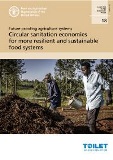
Future proofing agriculture systems - Circular sanitation economies for more resilient and sustainable food systems
2021
The Food and Agriculture Organizationof the United Nations (FAO) and the Toilet Board Coalition (TBC) have collaborated on this piece of work to shine a light on the benefits and rationale for agricultural systems, and the local and national contexts in which they operate, to champion circular sanitation economies and the products coming from them. This paper focuses on discussing the entry points of circular sanitation economies for the agriculture sector ...
Tracking progress on food and agriculture-related SDG indicators 2021
2021
The devastating COVID-19 has already shaken the 2030 Agenda for Sustainable Development to its very core and, as it continues, the full effect on the progress towards the achievement of the Sustainable Development Goals (SDGs) is still to be determined. The High-Level Political Forum noted that the world is “off track” to meeting the SDGs. The COVID-19 pandemic might have pushed an additional 83-132 million into chronic hunger in 2020.

Nature-based solutions in agriculture: Sustainable management and conservation of land, water and biodiversity
2021
In recent years, considerable progress has been made in the area of Nature-based Solutions (NbS) that improve ecosystem functions of environments and landscapes affected by agricultural practices and land degradation, while enhancing livelihoods and other social and cultural functions. This has opened up a portfolio of NbS options that offer a pragmatic way forward for simultaneously addressing conservation, ...
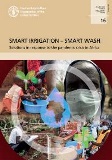
Smart irrigation – Smart wash: Solutions in response to the pandemic crisis in Africa
2020
Uncertainties related to the impacts of COVID-19 on daily life are increasingly growing. Inherent effects have grown beyond the well-defined sphere of health risks and have shocked the livelihood and food security in several countries. Particularly in the poorest countries, the impact is more devastating due to the limited availability of resources to slow down the spread of the disease. These countries require immediate actions to safeguard food security and human health.
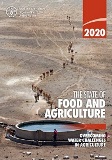
The State of Food and Agriculture 2020 - Overcoming water challenges in agriculture
2020
The State of Food and Agriculture 2020 presents new estimates on the pervasiveness of water scarcity in irrigated agriculture and of water shortages in rainfed agriculture, as well as on the number of people affected. It finds major differences across countries, and also substantial spatial variation within countries.
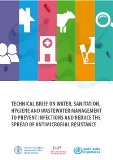
Technical brief on water, sanitation, hygiene and wastewater management to prevent infections and reduce the spread of antimicrobial resistance
2020
This technical brief provides information to inform Water Sanitation and Hygiene (WASH) and wastewater elements within multi-sectoral antimicrobial resistance (AMR) national action plans (NAPs). It includes a summary of evidence and the co-benefits rationale for action in each sector and presents a menu of actions for consideration and refinement in each country context.
Tracking progress on food and agriculture-related SDG indicators 2020
2020
In September 2019, the High Level Political Forum noted that the world is “off track” to meeting the Sustainable Development Goals. This echoed the main finding of the first edition of this report, issued in July 2019, that the world was not going to meet most of the food and agriculture-related SDG targets by 2030. Now, due to COVID-19, an unprecedented health, economic and social crisis is threatening lives and livelihoods, making the achievement of these targets even more challenging.
Browse by SDG
- SDG1: No Poverty
- SDG2: Zero Hunger
- SDG3: Good Health & Well-being
- SDG4: Quality Education
- SDG5: Gender Equality
- SDG6: Clean Water & Sanitation
- SDG7: Affordable and Clean Energy
- SDG8: Decent Work and Economic Growth
- SDG9: Industry, Innovation and Infrastructure
- SDG10: Reduced Inequalities
- SDG11: Sustainable Cities and Communities
- SDG12: Responsible Consumption and Production
- SDG13: Climate Action
- SDG14: Life Below Water
- SDG15: Life on Land
- SDG16: Peace, Justice and Strong Institutions
- SDG17: Partnerships for the Goals
Browse by Better
Browse by Priority Area
- Innovation for Sustainable Agriculture Production
- Blue Transformation
- One Health
- Small-Scale Producers' Equitable Access to Resources
- Digital Agriculture
- Healthy Diets for All
- Nutrition for the Most Vulnerable
- Safe Food for Everyone
- Reducing Food Loss and Waste
- Transparent Markets and Trade
- Climate Change Mitigating and Adapted Agrifood Systems
- Bioeconomy for Sustainable Food and Agriculture
- Biodiversity and Ecosystem Services for Food and Agriculture
- Achieving Sustainable Urban Food Systems
- Gender Equality and Rural Women's Empowerment
- Inclusive Rural Transformation
- Agriculture and Food Emergencies
- Resilient Agrifood Systems
- Hand-in-Hand Initiative
- Scaling up Investment
